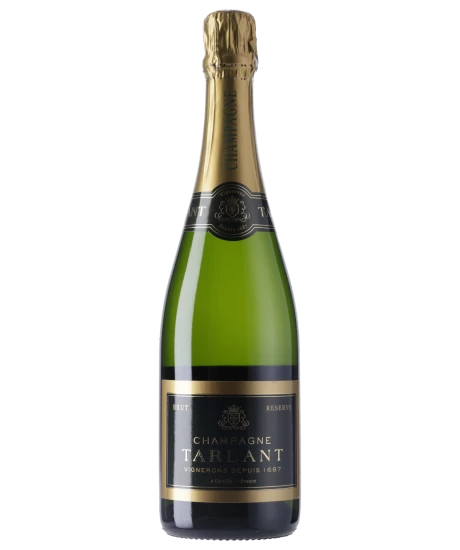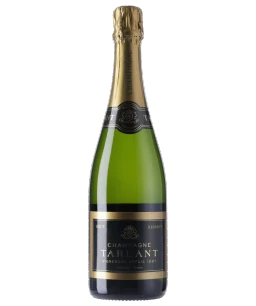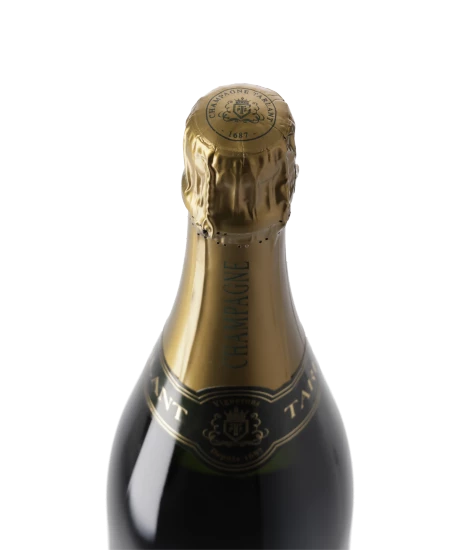Tarlant Brut Réserve
Tarlant Brut Réserve
AOC Champagne, 750 ml

Description
A challenging champagne highlight for lovers of the highest quality bubbles. First of all: this is not "just" an aperitif, but also an excellent accompaniment to meals from entrée to dessert! Due to the fermentation in wooden barrels and the exceptionally long ageing on the lees, the wide range of aromas is characterised by the scent of vanilla, yeast pastries, roasted hazelnuts and honey. Pineapple, apple skin and peach contribute the fruit components. The long-lasting mousse feels powerful and creamy in the mouth. The combination of intense fruit and a fine salty-mineral component in the flavour is extremely appealing. The siblings Melanie and Benoît Tarlant, two absolute luminaries, have rightly become an integral part of the champagne scene!
Our head sommelier Marc Almert about the Tarlant Brut Réserve
"Œuilly" – If you want to pronounce the name of this village in the Vallée de la Marne properly, you should ideally loosen up your tongue with a little champagne first. 😉 It would be hard to imagine the winemaker's champagne scene without this brother-and-sister team of Melanie and Benoît Tarlant, who call this village their home. Although their family history dates back to the year 1687, things have only really taken off for them in recent decades, during which time, as organic pioneers who have determinedly set about the separate development of forty self-managed plots, they have won over wine taster after wine taster – including yours truly. This cuvée may be billed as the "introduction" to the house but it bears the unmistakable hallmarks of their style: light maturation in wood of the base wine, extended yeast fermentation, completely dry, multi-layered and challenging in the best sense of the word – one for true lovers of champagne.
Celebrate the Art of Sabring!

With its elegant design, this champagne sabre is not only an impressive eye-catcher at any celebration and an indispensable tool for stylish sabering, but also the perfect gift for all passionate sparkling wine lovers.
Attributes
| Grape variety: | Chardonnay, Pinot meunier, Pinot noir |
| Producer: | Tarlant |
| Origin: | France / Champagne |
| Ripening potential: | 1 to 3 years |
| Drinking temperature: | 8 to 10 °C |
| Food Pairing: | Apéro riche, Bouillabaisse, Meat terrine, Coquilles Saint Jacques on lentils, Risotto ai frutti di mare, Cakes, biscuits, pastries |
| Vinification: | bottle fermentation |
| Harvest: | hand-picking |
| Maturation: | in steel tank, in small barrels, on the yeast |
| Maturation duration: | 72 months |
| Volume: | 12.0 % |
| Note: | Contains sulphites |
Tarlant
The Tarlant family can look back on a long family history, one that can be traced back to 1687. For almost three and a half centuries they have devoted themselves to viticulture in the Marne Valley in the Champagne region. But it was only after World War I that the first hugely successful Champagne Tarlant was created. Today, brothers Jean-Mary and Benoît operate the family-owned company.
With a total of 14 hectares spread over 55 plots, the winery is very small compared to other Champagne houses. Tarlant is a real insider tip, featured on the wine list of some of the world's most prestigious restaurants, and it was not easy for Baur au Lac Vins to come by a few bottles. These sparkling wines are unusual, but all the more fascinating for it.
Vigne d'Antan, Vigne d'Or and La Vigne Royale belong to the winery's limited premium range. The grapes each come from a particular location. The Chardonnay vines for the Vigne d'Antan are authentic, meaning they are ungrafted. The Vigne d'Or is made from 100% Pinot Meunier, which is really unusual in the Champagne region, and can be described as a rarity. La Vigne Royale is a pure Pinot Noir.
The hand-picked grapes are gently pressed in the traditional basket press. The fermentation and maturation of the basic wines are carried out in barrels. Tarlant attaches great importance to a particularly long bottle ageing on the yeast, so the flavours can fully develop. This can easily take seven to ten years. These Champagne wines are always dry and receive little or no dosage.
Even for the Champagne connoisseur, these hidden gems will make for a most unusual discovery!
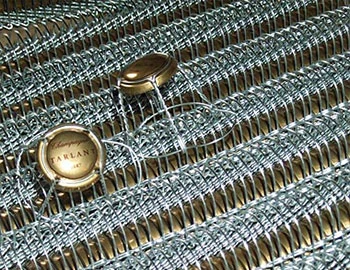
Pinot meunier
Freshness boost for champagnes
Many fine white hairs on the underside of the leaves give this red grape its name. "Meunier" translates to miller, an allusion to the impression that the plant has been dusted with freshly ground flour. Its main habitat is in Champagne. Alongside Pinot noir and Chardonnay, it forms the third component of the classic champagne cuvée. It contributes fresh acidity and youthful fruit to the sparkling wines. It is only very rarely into champagne by itself, but the few examples are worth tasting. In German, Pinot Meunier is also known as Müllerrebe or misleadingly as Schwarzriesling (black Riesling).
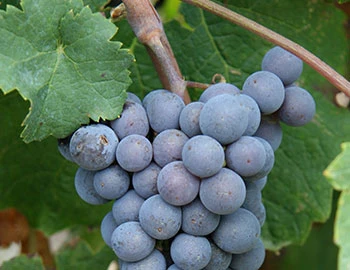
Pinot noir
Blueprint of the terroir
No other variety expresses its terroir as precisely as Pinot noir. It is a sensitive, fragile grape. But when it succeeds, it gives the world some of its very greatest wine plants. It especially excels in Burgundy, where it has been cultivated for at least 700 years. Even in the middle ages, it was considered so precious that it was kept separate from other grapes so as to not diminish its value. The finest examples are delicate and fragrant with aromas of cherries and red berries. With maturity, notes of forest floor, leather and truffles enter as well. An irresistible fruity sweetness still shines through, even after several decades. The Pinot noir does well in cool locations: in Switzerland and in Germany, where it is known as Blauburgunder and Spätburgunder respectively; in Alsace and in South Tyrol, in Oregon, New Zealand and Tasmania. Not least, it yields fantastic champagnes. It is a wonderful culinary companion. With its soft tannins and charming bouquet, it meshes with everything, from Güggeli and cheeses to fried fish.
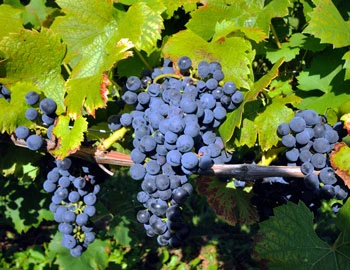
France
France – Philosophy in a bottle
According to French philosophy, wine should be an expression of the soil and climate. They use the word “terroir” to describe this. Terroir makes every wine different, and many especially good. French wine is regarded worldwide as an expression of cultural perfection. The French believe that humans are responsible for the quality of the berries, the vine variety for their character, and nature for the quantity. This philosophy can be expressed succinctly as: “the truth is the vineyard, not the man.”


